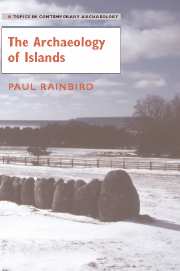Book contents
- Frontmatter
- Contents
- Figures
- Acknowledgments
- 1 A Consciousness of the Earth and Ocean: The Creation of Islands
- 2 Seas of Islands: Anthropology, Biogeography, Archaeology and Postcolonialism
- 3 An Archaeology of the Sea
- 4 The Mediterranean: Malta
- 5 Oceania: Pohnpei and the Eastern Carolines
- 6 The Baltic: Gotland
- 7 Atlantic Archipelago: The Western Seaways of Europe
- 8 Conclusion – Islands and Histories of the Sea
- References
- Index
5 - Oceania: Pohnpei and the Eastern Carolines
Published online by Cambridge University Press: 03 December 2009
- Frontmatter
- Contents
- Figures
- Acknowledgments
- 1 A Consciousness of the Earth and Ocean: The Creation of Islands
- 2 Seas of Islands: Anthropology, Biogeography, Archaeology and Postcolonialism
- 3 An Archaeology of the Sea
- 4 The Mediterranean: Malta
- 5 Oceania: Pohnpei and the Eastern Carolines
- 6 The Baltic: Gotland
- 7 Atlantic Archipelago: The Western Seaways of Europe
- 8 Conclusion – Islands and Histories of the Sea
- References
- Index
Summary
The thousands of islands of Oceania, excluding the island-continent of Australia and the very large island of New Guinea, are regarded by many as the theatre for island archaeology par excellence. We have already discussed in Chapter 2 how Epeli Hau'ofa describes the region as a ‘sea of islands’. John Cherry (2004) in reviewing Mediterranean archaeology not only comments on the many models and analogies borrowed from Oceania, but he also wonders whether if this is at all appropriate (cf. Doumas 2004) given that only in the Pacific Ocean do islands have the distance from continental mainland to make the principles of island biogeography worthy of application. This makes sense given that the Galapagos Islands where Charles Darwin first made observations which would be used to establish the principles of island biogeography are located in this ocean. But in the same way that Cherry and others can question the appropriateness of using cases from Oceania in aid of interpretation of island societies in the past of the Mediterranean, we can ask how applicable the principles of island archaeology are to the long history of island usage in Oceania.
ISLAND HISTORIES IN OCEANIA
By the beginning of the last Ice Age 35,000 years ago, New Guinea and Australia had been settled by humans. At the height of the last Ice Age, c. 18,000 years ago, when sea levels were at their lowest due to water being trapped as ice in the polar regions, Australia and New Guinea formed a single land mass, known to Quaternary scientists as Sahul or Greater Australia.
- Type
- Chapter
- Information
- The Archaeology of Islands , pp. 90 - 113Publisher: Cambridge University PressPrint publication year: 2007



